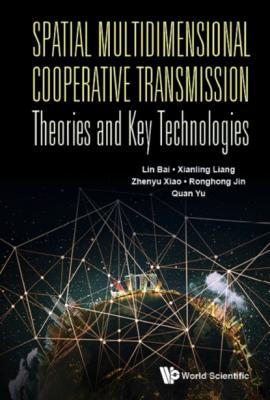Spatial Multidimensional Cooperative Transmission Theories And Key Technologies. Lin Bai
Читать онлайн.| Название | Spatial Multidimensional Cooperative Transmission Theories And Key Technologies |
|---|---|
| Автор произведения | Lin Bai |
| Жанр | Зарубежная компьютерная литература |
| Серия | |
| Издательство | Зарубежная компьютерная литература |
| Год выпуска | 0 |
| isbn | 9789811202476 |
Finally, the diversity gain has upper and lower bounds at high SNR7 (Chernoff bound is a good approximation of SER at high SNR)
It means that the error rate is a function of the SNR and the slope of the curve is MTMR. The full diversity gain MTMR is obtained by the dominant eigenmode transmission.
(2) The dominant eigenmode transmission with antenna selection
The principle of the dominant eigenmode transmission with antenna selection is as follows. First, the matrix set H′ consisting of
The average SNR can be calculated according to the method provided in Ref. 7, and the corresponding array gain is
where
where aS is the coefficient of um of
Similar to the traditional dominant eigenmode transmission, if all transmit antennas are used, the antenna selection algorithm can obtain the same diversity gain, which means the diversity gain is MTMR.
(3) Multi-eigenmode transmission
The eigenmode transmission will not achieve multiplexing gain when the same symbol is sent to all transmit antennas. As an alternative, the system throughput can be increased by maximizing spatial multiplexing gain. For this purpose, the symbols are spread over the non-zero eigenmode of all channels. Assuming MR ≥ MT, the channel matrix is an independent and identically distributed Rayleigh channel, and singular value decomposition is made for the channel matrix by Eq. (2.125). If the transmitter uses the precoding matrix VH to multiply the input vector c(MT × 1) and the receiver uses matrix
It can be seen that the channel has been decomposed into MT parallel SISO channels given by {σ1, . . . , σnt}. It should be noted that if MT virtual data channels are established, all of these channels will be fully decoupled. Therefore, the mutual information of the MIMO channel is the sum of the SISO channel capacities.
where {p1, . . . , pMT} is the eigenmode power allocation for each channel, satisfying the normalization condition
2.3.4.2MIMO system without transmit channel information
When the transmitter has no channel information, multiple antennas can be used at the transmitter and receiver ends to achieve diversity and increase the system capacity. This can be realized by spreading the symbols over the antenna (space) and time using the so-called space–time coding. In the following, the space–time block code will be briefly introduced.
Similar to MISO system, two symbols c1 and c2 are simultaneously transmitted from antenna 1 and antenna 2 in the first symbol period, and the symbols –
Assuming that the flat fading channel remains unchanged in the two consecutive symbol periods, the 2 × 2 channel matrix can be expressed as
It is worth noting that the subscripts here represent the receive and transmit antenna labels instead of the symbol periods. The signal vector received by the receiving array in the first symbol period is
The signal vector received in the second symbol period is
where n1 and n2 are additive noise components per symbol period of the receive antenna array (the subscripts represent symbol periods instead of antenna labels). Therefore, the receiver produces a mixed signal vector
Similar to the MISO system, two symbols c1 and c2 are transmitted during two symbol periods of two transmit antennas. Therefore, matrix Heff is orthogonal to all channel information, namely
If
where n′ satisfies E{n′} = 02×1 and
The average output SNR is
